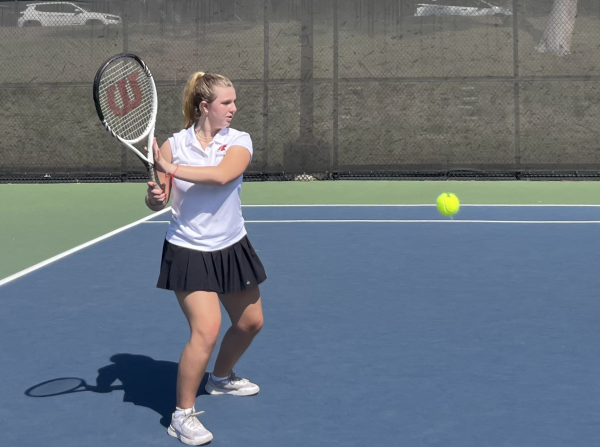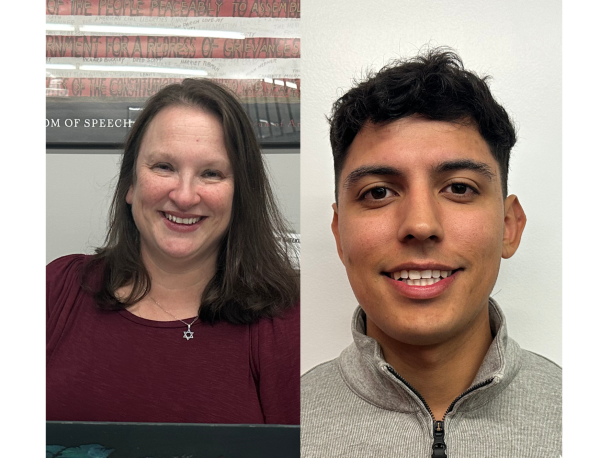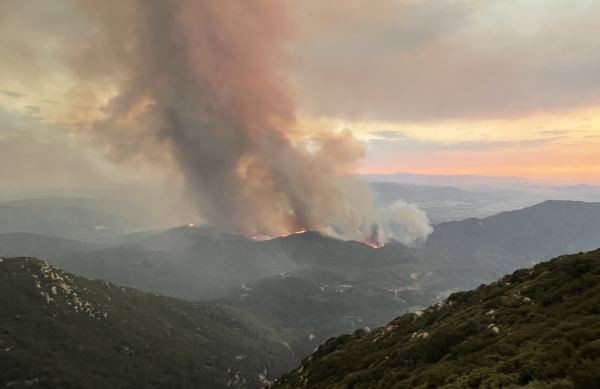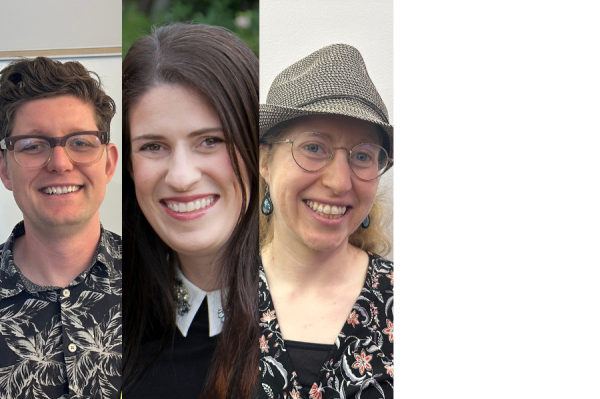SENIORS IN POLAND – At day’s end, ‘I sang because I can’
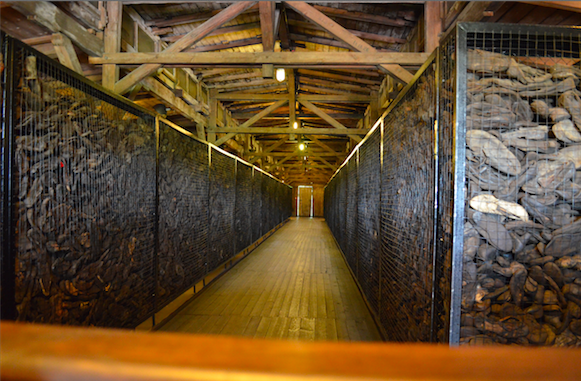
GOD’S ABSENCE: One barracks at Majdanek is filled with thousands of shoes taken from prisoners as they arrived.
May 20, 2015
By Shana Chriki, 12th grade
Shoes. Millions of shoes clumped together, they looked like one. Big shoes, women’s shoes, kid’s shoes and baby shoes. As I stared at the tiny shoe in the box to my left I couldn’t stop thinking about my little brother. If we’d been born 70 years ago, this could have been us. He could’ve been holding my hand as we walked through the camps of Majdanek.
I had seen pictures of piles of shoes many times throughout my Holocaust education, but now I saw the shoes in the place where they were taken, stolen. My pink Nikes, that I wore to avoid getting my white high tops dirty in the rain, hugged my feet as I lifted my heels into a tiptoe, craning my neck to glimpse the endless pathway of shoes. Tears were flowing down my face as I imagined my brother, Elie, beside me. It was so hard to fathom how people had the ability to kill precious children and babies — didn’t they too have children in their family that those little shoes reminded them of?
We walked into the crematorium at Majdanek where a group of us presented a talk about daily life there, and then we lit three candles in memory of those who perished at this atrocious site. As we sat with our rabbis, we sang because we can, we sang because we survived. Sitting by the crematorium I imagined bodies being burned, envisioned the ashes that were once bodies, and didn’t feel comfortable joining in singing Hinei lo yanum vlo yishan, shomer Yisroel – the Guardian of Israel neither slumbers nor sleeps. I know they weren’t necessarily songs of happiness, but still, I felt God’s absence, and I couldn’t bring myself to sing Jewish songs with my friends. It was too hard.
When we reached the last song, Rabbi Segal asked that we all sing together. He said he understood that we were having a hard time but pleaded that we try the best we can. As I sat looking at the ovens, I sang, I sang with my classmates as we held each other. I sang because it is my job to show Hitler that we’re still here, and thriving at that. I sang because it is my duty to ignite the memory of the many Jewish people who died in this death camp. I sang because even though I felt God’s absence, I also believe that he exists. I sang because I can.
Auschwitz-Birkenau: A merger of silence and speech
By Alexa Fishman, Editor-in-Chief
I used to think that silence was something to avoid. Something awkward. The sign of a lull in a conversation. But today, I experienced a different kind of speechlessness. I watched as my friends sat apart from one another—not talking —on the steps overlooking the crematorium at Birkenau. For the first time, I felt comfort in silence. Nobody had to speak because the tears and silence said it all.
After experiencing Majdanek yesterday, I believed that Auschwitz I and II could not be more traumatic. I had become sick to my stomach at Majdanek, and I even left the group for a few minutes to close my eyes and force myself to take deep breaths. As we set out on the hour-long bus ride to the town of Oswiecim, I promised myself that I would handle Auschwitz I and Birkenau better than Majdanek. I vowed not to fall apart in my hotel room again once we returned.
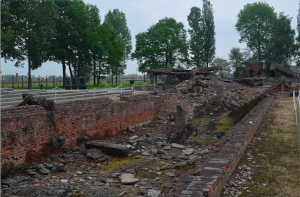
REMAINS: As the Red Army approached at the end of the war, Nazis destroyed this gas chamber in Auschwitz.
As we began our walk into Birkenau, the largest and most deadly sub-camp of Auschwitz, I felt as though I was in a black-and-white photograph. I marched on the train tracks and approached the large, brown building that was the entrance. I had seen that building in photos of Birkenau, and I felt shivers creep up my spine. We shuffled in single file, overwhelmed at the sheer size of the facility. Nobody was talking to each other, but we held hands. Soon, we passed a giant field of brick chimneys—the barracks that had housed families had been destroyed by the Nazis as they fled, and all that remained were hundreds of chimneys. We walked past the women’s camp, a cable car on the rail, and the ramp used for the selection. I wanted the sadness and anger to wash over me. I wanted to feel the tears, but they just wouldn’t come.
And then the tears came. Our group stood in a circle next to the destroyed gas chamber and crematorium and sang. As I powerfully belted out the song, Ani Maamin B’emunah Sheleima — which means I believe in God with full faith — a thought suddenly crossed my mind. I wanted to yell at everyone who’d called the Nazis “dehumanized” throughout our trip here. People claimed that the Nazis were so far gone that they didn’t have an ounce of morality in them, but that couldn’t be true. Clearly they knew how despicable their gas chambers were, which is why the facility now lay in broken piles of rubble—scattered and broken piles like the ashes of my people in a mound at Majdanek. The Nazis destroyed their gas chambers before the Red Army could liberate the camp, apparently attempting to protect their reputations.
After we finished singing, teacher Ruthie Skaist and principal Reb Noam Weissman handed us letters that our parents had written to us. I wasn’t expecting to be able to connect to my parents all the way from Poland, and I welcomed the surprise. Crying even more, I sat alone at the foot of the gas chamber and read my letter, which reminded me of my responsibility to speak up for my people. My dad wrote to me about my relatives in America, who along with most American Jews, did not lobby and fight for the Jews in camps—despite the rumors that reached America. Although I was surrounded by silence, I vowed to myself that if I needed to fight for my people, I would. Whether it was BDS or violent anti-Semitism, I wouldn’t make the same mistake that American Jews during the war did.
I experienced such profound silence and such a desire to speak out, criticize, and teach. Although they don’t usually work together, I finally understand how profound silence and powerful speech could coexist. Here in Poland anything goes.
From the cold floors of Majdanek
By Adam Kaufler, 12th grade
Throughout our trip we have been accompanied by the journal of Helene Birnbaum, a concentration camp survivor who later journaled everything she went through during the Holocaust. Thus when we stepped off the bus at Majdanek, we saw the place of the nerve-wracking selection process through the lens of a teenaged girl.
In reading an excerpt from her memoir, there was one part that stuck out to me in particular. Just like any other teenager, patience was not Helene’s forté. Unaware of what the selections were for, she described her dread of standing in that long line with her mom, and couldn’t wait for it to be over. Little did she know that standing in that line with her mother was the last time they would be together, as her mom was soon sent to the left.
I don’t think I need to explain the emotion behind an unassuming moment with your mom, and the next thing you know she is gone forever. Upon hearing that story and then walking to the gas chamber, which was just a few steps further, the only person I wanted to see and hug was my mom.
Inside a newly built museum in the camp, an interactive screen displayed the deluge of files that the Nazis kept. They took meticulous notes on each inmate, officer and even objects that they had. Whether it was a log of each and every SS officer’s schedule or a death certificate of an inmate, the attention to each detail was astonishing. One thing I took from this and other things was the utter lack of emotion among the Nazis as they carried out such murders. Killing Jews became a discipline to them above all else. Listening to testimony of some of the sadistic things they would do literally made me sick to my stomach. Some even took sexual pleasure in caressing the lifeless bodies of victims they had just brutally murdered. The Nazis focused on the dehumanization of Jews, but is it possible to have committed the acts that the Nazis did and for them to remain human?
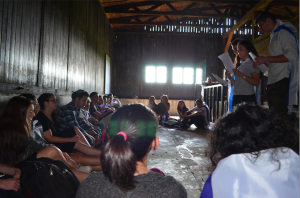
COLD: A mix of emotions flooded seniors sitting on the hard floor in front of the ovens at Majdanek.
This doesn’t remain all gloomy. My experience in the crematorium was, ironically, a true moment of inspiration. We gathered in a circle sitting on the floor. In the face of the absolute terrifying realities of life in the camps, we internalized by singing. Sitting on the floor of a room where thousands upon thousands of Jews were cremated and where the Nazi goal was to erase the Jewish people, singing Jewish songs that have been with us for 2,000 years sent chills through my body. I really cannot find the words to justly express this emotion.
What I can say, however, is that I took from those cold floors of the crematorium a sense of responsibility to make whatever it is that involve myself with a worthwhile and meaningful endeavor. I feel the responsibility to make the best of what I can control in life, because for millions, life was cut so short.
Never forget. Never again.
Lublin: Connecting with generations in the home of ‘daf yomi’
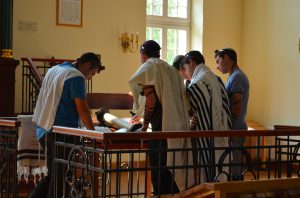
MORNING: Avishai Rabin, second from left, lains the parsha as fellow seniors Mati Hurwitz, Daniel Steinberg and Max Helfand looked on during the Rosh Chodesh Torah reading at Yeshivat Chachmei Lublin in Poland on Tuesday.
By Mati Hurwitz, Sports Editor
On our first day in Poland, I had my first true experience with European Jewry in Lublin. Not just because we visited the horrific camp in Majdanek, but because I got to connect with generations of Jews of the past, Jews with different backgrounds and upbringings.
My day and primary experience started at Yeshivat Chachmei Lublin (YCL), when I felt connected to the top talmidei chachamim of the 1930s. That yeshiva was run by R’ Meir Shapira – who also instituted daf yomi study and spread it throughout the world – and was home to the brightest and sharpest students, who could only be admitted by passing the famous pin test. Next year I am going to one of the most prominent yeshivot and Torah centers in the world, Yeshivat Har Etzion (“The Gush”), and I really enjoyed learning about the greatness of YCL. It was a humbling experience because I know that I would never be capable of passing the YCL admission exam. Because the Germans ransacked the place, the yeshiva never regained its prominence and the world lost an incredible Torah center. However, we Shalhevet seniors honored its legacy yesterday!
As part of a group presentation, Jeremy Glouberman and I taught part of Tuesday’s daf yomi, or daily page of Gemara. In Ketubot 106a, the Gemara discusses a series of rabbis and numbers of their students who left their yeshivot. Jeremy and I connected it to how Rav Shapira mobilized Torah study for both elite and non-elite Torah learners by spreading daf yomi. Even when a large chunk of the world’s Talmud Torah was lost, whether from the destruction of YCL or the Amoraim’s fleeing from their yeshivot almost 2,000 years ago, the Jewish people have constantly been creative and found new ways to keep the fire of learning burning. Daf yomi is hardly an intense study of Talmud, but it connects Jews across the world every single day.
Earlier in the morning, Jeremy and I had stumbled upon a Gemara Ketubot in the yeshiva. We felt instantly connected to the globalization of Talmud Torah. When we were teaching our fellow rabbis and students, I felt like I was a middle man between Rav Shapira and the common Jew. I felt empowered: I was embodying the creation of one of the most impactful Talmud Torah programs in the world in the place where it was born! I felt the spirit of Jewish resilience and strength at YCL more than at any moment in Majdanek or the cemeteries we visited. The Nazis destroyed the greatest yeshiva but thanks to Rav Shapira, among others, they could not kill the flame of our people and its thirst for Torah.
The experience in YCL made even more powerful because earlier in the day, we had danced and sung Hallel there. It was Rosh Chodesh Sivan, and another Orthodox high school, Kushner of New Jersey, was also there; we circled up with them and melodically praised Hashem. Then, before we left, Jeremy and I put our own copies of the daf yomi on each shtender in the shul at YCL, hoping that whoever might walk in could learn the daf and connect to Jews worldwide in the original founding home of daf yomi.
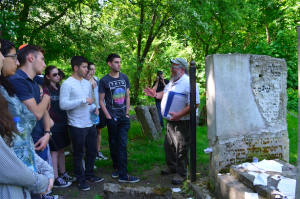
CONNECTION: A guide told Shalhevet seniors the story of the Chozeh of Lublin beside his grave May 19.
While YCL was definitely the highlight of my day Tuesday, I felt linked to not only the elite religious scholars of Poland, but to all sects of Judaism. We visited the gravesites of the Chozeh of Lublin and Rabbi Noam Elimelech, two legendary Hassidic figures. As students and our tour guide shared stories of those two men, I started connecting to Hassidism. I really am not a big fan of Hassidic Judaism and frankly find some of its practices very odd and questionable, but for once I almost felt like one of them. Although it was very abnormal, we rejoiced and danced around the grave of R’ Elimelech. Instead of being solemn and sorrowful at a kever, we embodied the Hassidic spirit by joyously celebrating God, life, and Judaism.
In between the two cemeteries, we spent hours in Majdanek at the concentration camp. I was not too emotional, but fascinated with the beautiful fields at the camp and as I pondered how much brilliance and time had gone into its construction and the plotting of the Holocaust. I had a religious experience not only mourning the loss of hundreds of thousands at Majdanek, but wondering how the Nazis devised their plan to wipe out the Jews and were able to build these camps so meticulously. Walking through museum exhibits and recalling personal accounts, I learned about how the Nazis psychologically broke down the Jewish people.
But as we sang in the crematorium, I definitely felt my final connection of the day: to all Jews. Not just frum Jews and Talmud scholars or Hassidim, but any kind of Jewish person who had been in Poland. Nothing mattered to me except the fact that we all share the same faith. Secular or religious, every kind of Jew suffered in Majdanek. The way that I think I felt their spirits was when we sang “Acheinu” — right next to the ovens in which the Nazis turned us into ashes.
Me’afeila l’ora! we shouted! “From darkness to light.” The poor victims of the Holocaust suffered in darkness, but as the strong people we are, Am Yisrael rose from the ashes into the light. The theme of this trip is Me’afeila l’ora, as we go from Poland to our gift of Israel and connect the rich history of our people.
The Jewish people will never be wiped out and I am so glad I had the opportunity in a single day to be exposed to every sect of our eternal faith and become the next link in the chain.
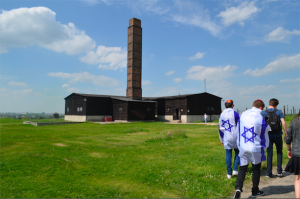
SMOKESTACK: Clearly visible from the surrounding city of Lublin, the chimney at Majdanek jutted into a blue sky in a scene of unsettling beauty as seniors on the Poland-Israel trip approached.
Day 1 – Majdanek: Endless death in the heart of a city
By Sigal Spitzer, Staff Columnist
“With your permission, a quick moment of silence until we reach our final destination,” said Yonatan, our tour guide, en route to Majdanek. I didn’t think the moment of silence would last until we arrived at the concentration camp. Someone was bound to ruin the silent 20-or-so-minute drive, I thought to myself, as I stared at the yellow and red public transportation busses overcrowding the streets of Poland. There were schoolchildren holding hands crossing the street to get to school and adults completing their weekly shopping at the local fresh fruit market. Life was normal and the city was vibrant, as the moment of silence on the bus continued.
All of a sudden, about 45 seconds after Yonatan asked for quiet, the bus arrived in the still, yet scenic plot of land – Majdanek. It was covered with endless barbed wire and interminable watch towers. The tall grass swayed in the breezy and sunny day in the middle of May. Dark brown bunkers lined the fields and the tall chimney of the crematorium did not hide the Nazi secret of extermination. A massive pile of ash filled the monumental rock just outside of the camp and birds peacefully chirped as they flew around above us. It was strangely beautiful. But as the moment of silence on the bus was broken by curse words and deep gasps from students shocked at the sight outside the bus window, I started to cry.
For the first time in my life, after almost 18 years of Holocaust education, the millions of photos and thousands of videos I had seen became a reality. It was no longer a black and white stream of evilness rotating across my TV. It was no longer a resentful thought in my mind based upon stories I had heard from survivors. The death camps and labor camps were real. They existed in the middle of Poland. In the heart of a city.
I thought to myself: what would be if I arrived at the camp just 70 years earlier. Would I survive? Would I be tortured? Would I ever see my family again?
To my surprise, Majdanek was a colorful camp lined with green trees, brown buildings, red and orange shoes, blue gas stains and purple flower buds. It was not a camp located in the middle of the forest, but rather in the heart of Lublin. The beauty contrasted with the historical disgust of the place.
As we walked into Majdanek, our teacher Ruthie Skaist handed out Israeli flags. I grabbed one from her hand and wrapped it around my body for protection. Inside, we began to follow the story of Helene Birnbaum. She was a 13-year-old girl when she arrived in Majdanek with her mother, but they were quickly separated as she went to the showers and her mother to the gas chambers.
Standing at the selection barrack where Helene Birnbaum and her mom were separated, I noticed a park adjacent to the camp. A woman walked by with her black lab and red leash continuing her daily life. A group of men jogged by in neon colors and trendy Nike shoes. Strange. How could the death of 360,000 Jews have taken place in the midst of a city? How could the Polish bystanders have let this happen? Why did the prisoners not run away to Lublin?
So many questions flooded my mind as I continued to somberly follow Helene Birnbaum’s path. We walked through the clothing swap station, where Helene records her older cousin taking care of her after her mother was killed. She was forced to strip naked in a room full of woman who did the same. Her older cousin was brave enough to steal a nicer pair of shoes, but Helene would not resist against the Nazis.
We continued in the same building to where Helene’s mother took her last footsteps – into the gas chamber. There were two rooms. Both are still equipped with gas that can turn the room into another death bed in seconds. The evil inside again contrasted with the beauty outside, the green tall grass and shining hot sun.
Next, we followed Helene’s footsteps around the camp. First to a barrack lined with thousands upon thousands of shoes. Each shoe revealing a different story, representing a different individual Jew, all lost during the painful war. Then to Barrack 14 filled with triple-decker bunk beds that squeezed 500 people into a max capacity space of 150. It was too hot for me to even remain in the room. I can’t imagine what the inmates experienced in the middle of summer.
Finally, we walked through the remnants of Area 3 and reached the crematorium, the last stop within the physical camp of Majdanek. Uncomfortably, we began to sing. In the middle of Majdanek, we sang. We belted out Ve’Zakeni Legadel, Achenu Kol Beit Yisroel and Ve’Hi Sheamda as one cohesive family. Some continued to cry. Some flashed smiles across the room. And some remained silent, still in the shock of our two hours spent inside the camp.
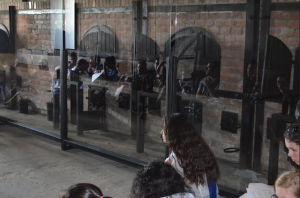
GHOSTS: Gazing into the walled-off ovens of the crematorium, seniors’ reflections in the clear barrier connected the present with the past.
At first, I felt uncomfortable singing in front of ovens built to wipe out my people, to destroy the Jewish nation forever — especially after the experience I underwent when walking through the camp. But the warmth of the voices that surrounded me and familiar echoes bouncing off the concrete walls of the room encouraged me to slowly join in. As we sat there and sang, I reminded myself of just how blessed I am to be a Jew. Hitler tried to destroy us, but we survived. And there was no better way to express my amalgamation of emotions than sitting in a circle with my arms around my closest friends and teachers, singing our ancestral songs.
Majdanek was a heavy first site to visit. But an important place to see — one that fosters strength, positivity and optimism. Am Yisroel Chai. We are here.








